Master's Dissertation: Fresh Produce Consumer Awareness, Practices
VerifiedAdded on 2023/03/29
|153
|42956
|426
Thesis and Dissertation
AI Summary
This Master's dissertation in Public Health investigates consumers' awareness, knowledge, and practices concerning fresh produce, including pre-packaged fruits and vegetables, in Australia. The study aims to identify gaps in consumers' food safety knowledge and assess their associated risk of foodborne illness. The research involved an online survey of 433 participants across Australia, gathering data on their food handling practices and understanding of food safety risks. The findings reveal that, while some areas of food safety knowledge are good, there are significant gaps in detailed knowledge, particularly regarding handwashing practices and microbial risks. The dissertation also includes a literature review of relevant outbreaks, pathogens, and risk factors, along with an analysis of the methodology, results, discussion, and conclusions, offering recommendations for future research and improved consumer education.
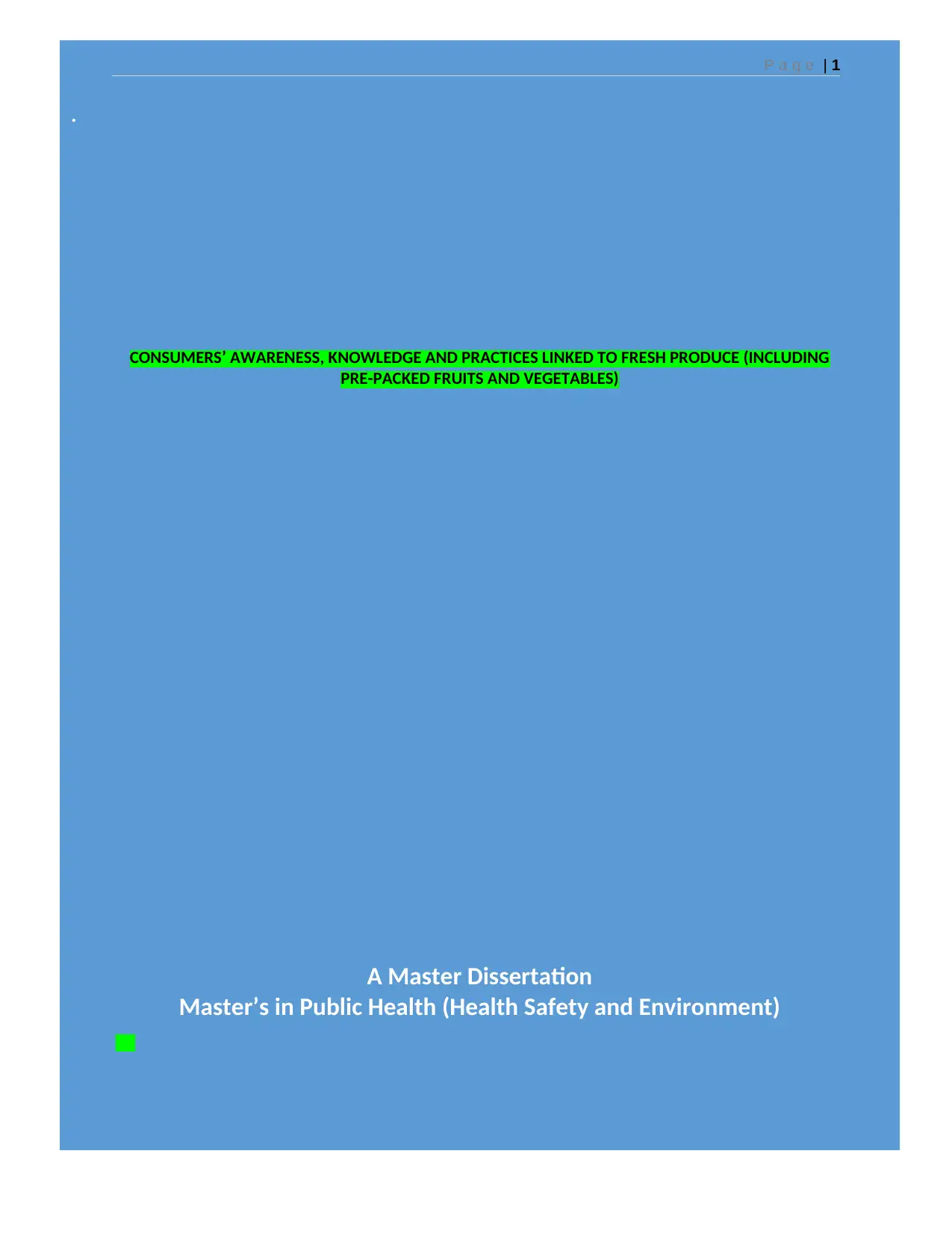
.
A Master Dissertation
Master’s in Public Health (Health Safety and Environment)
CONSUMERS’ AWARENESS, KNOWLEDGE AND PRACTICES LINKED TO FRESH PRODUCE (INCLUDING
PRE-PACKED FRUITS AND VEGETABLES)
P a g e | 1
A Master Dissertation
Master’s in Public Health (Health Safety and Environment)
CONSUMERS’ AWARENESS, KNOWLEDGE AND PRACTICES LINKED TO FRESH PRODUCE (INCLUDING
PRE-PACKED FRUITS AND VEGETABLES)
P a g e | 1
Paraphrase This Document
Need a fresh take? Get an instant paraphrase of this document with our AI Paraphraser
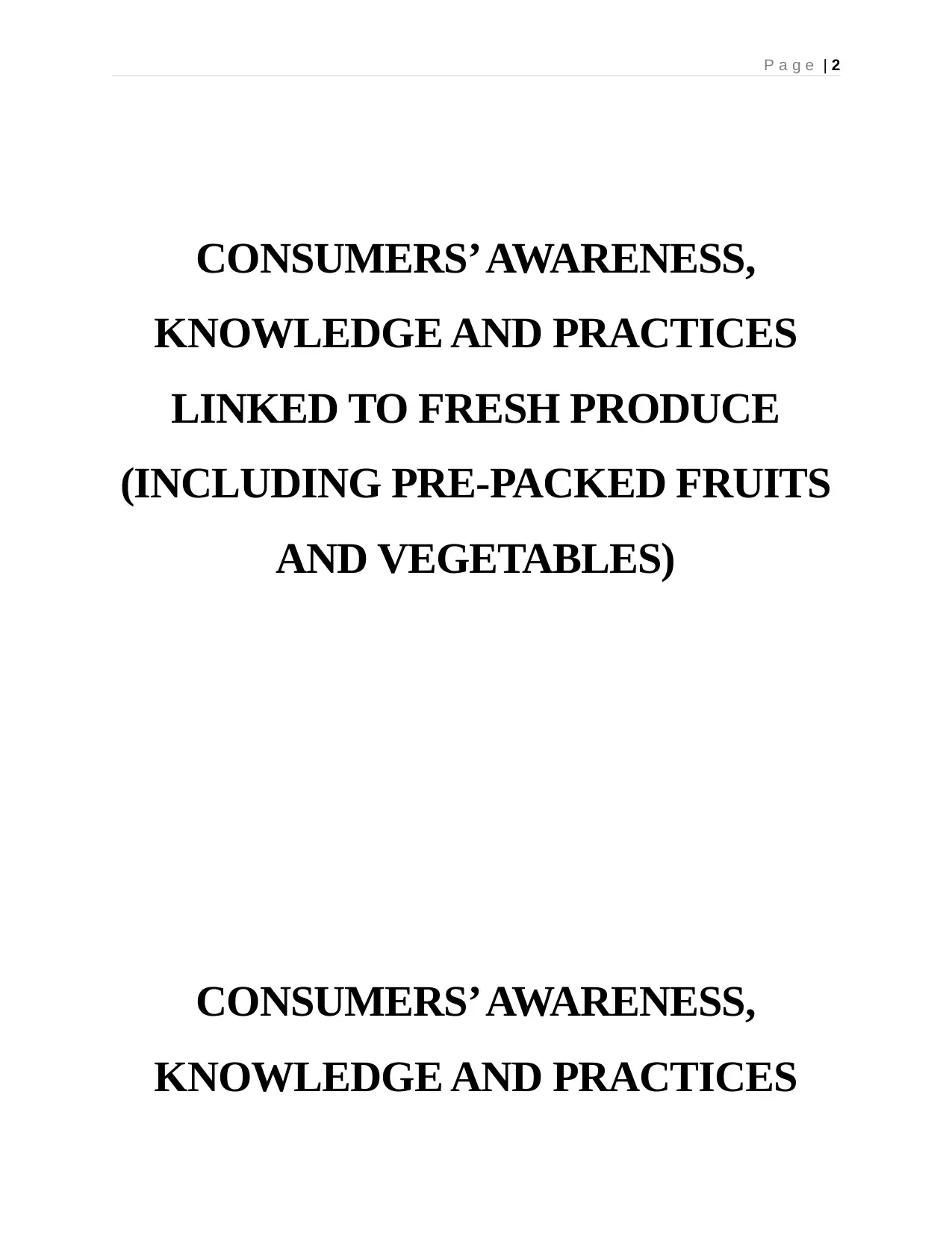
P a g e | 2
CONSUMERS’ AWARENESS,
KNOWLEDGE AND PRACTICES
LINKED TO FRESH PRODUCE
(INCLUDING PRE-PACKED FRUITS
AND VEGETABLES)
CONSUMERS’ AWARENESS,
KNOWLEDGE AND PRACTICES
CONSUMERS’ AWARENESS,
KNOWLEDGE AND PRACTICES
LINKED TO FRESH PRODUCE
(INCLUDING PRE-PACKED FRUITS
AND VEGETABLES)
CONSUMERS’ AWARENESS,
KNOWLEDGE AND PRACTICES
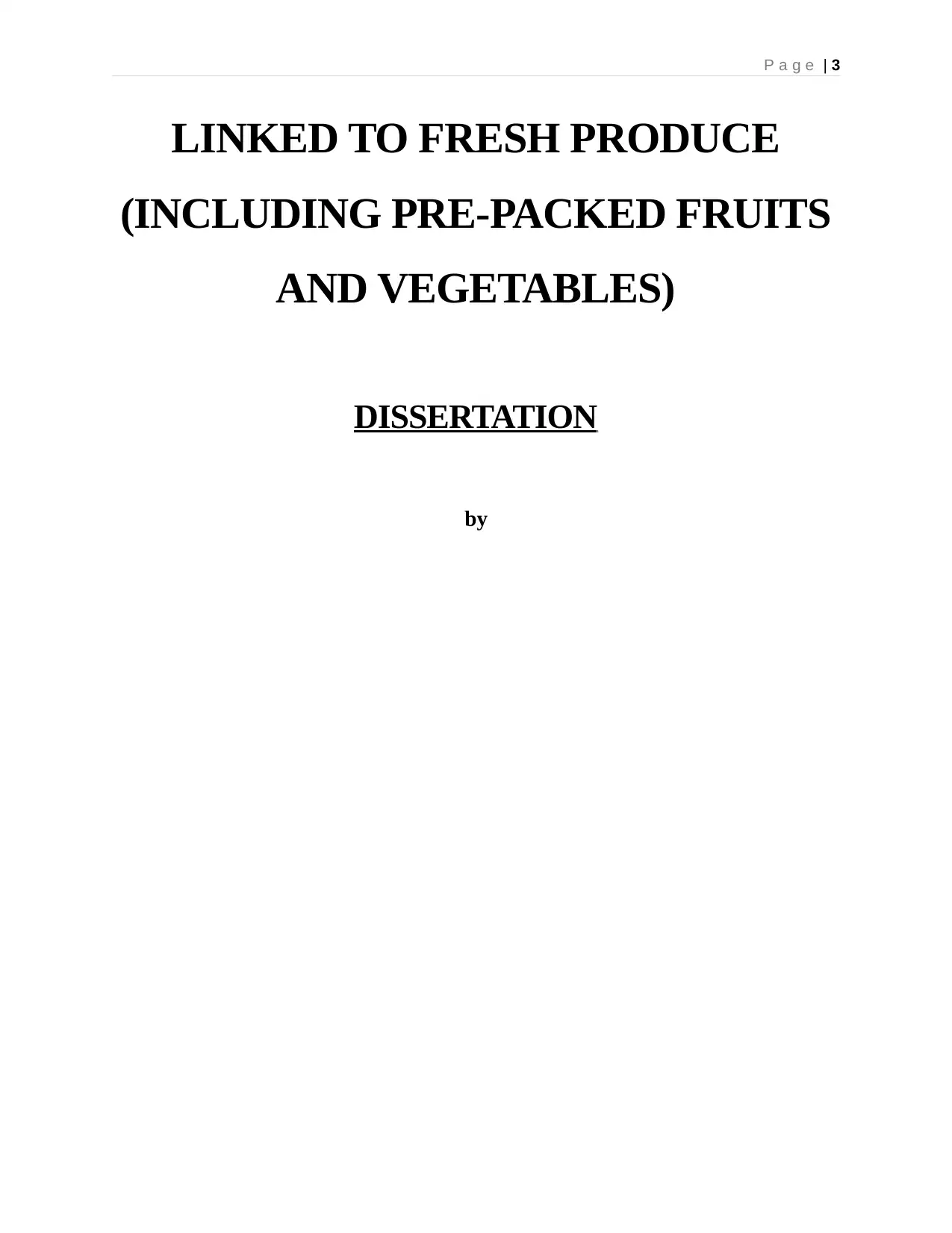
P a g e | 3
LINKED TO FRESH PRODUCE
(INCLUDING PRE-PACKED FRUITS
AND VEGETABLES)
DISSERTATION
by
LINKED TO FRESH PRODUCE
(INCLUDING PRE-PACKED FRUITS
AND VEGETABLES)
DISSERTATION
by
⊘ This is a preview!⊘
Do you want full access?
Subscribe today to unlock all pages.

Trusted by 1+ million students worldwide
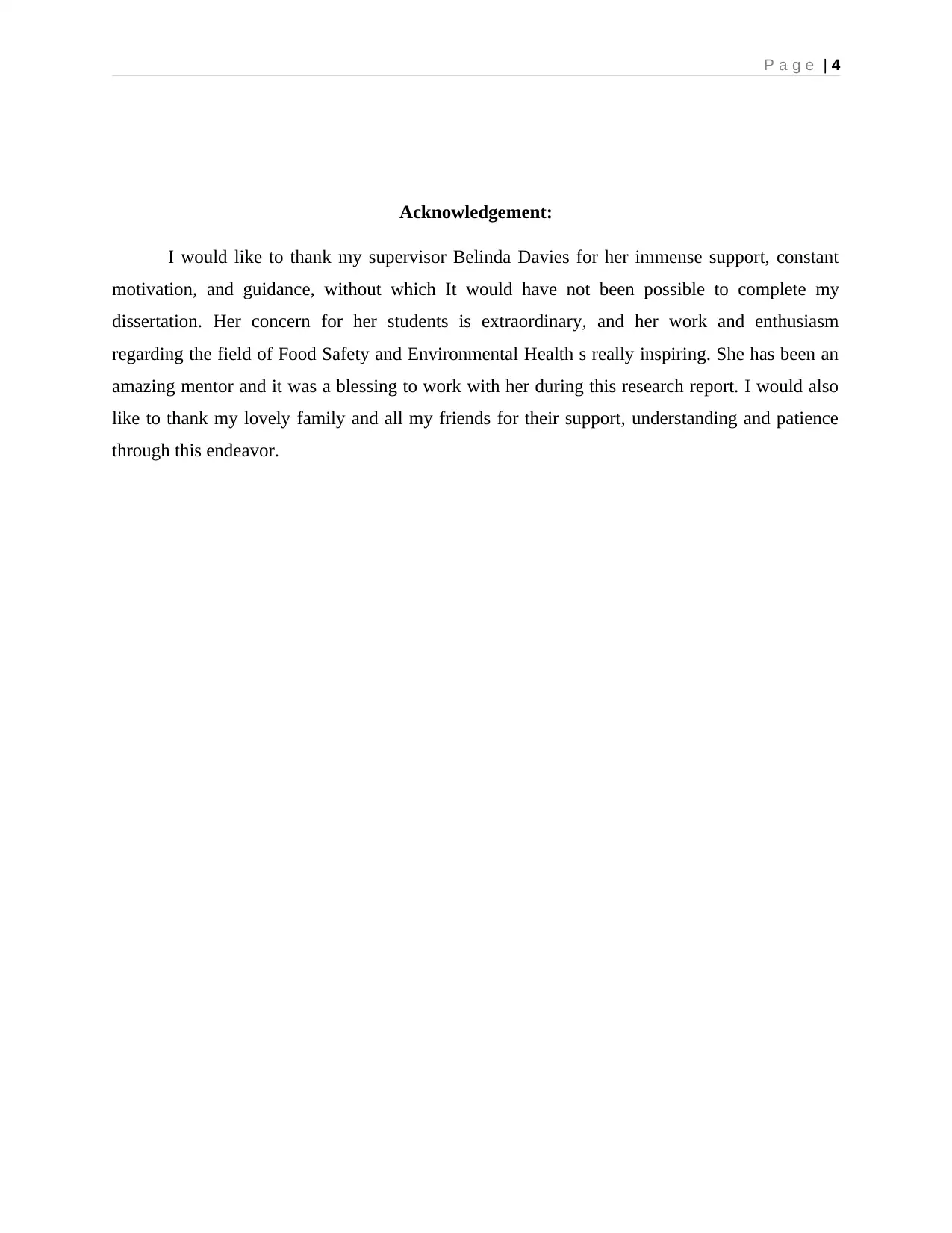
P a g e | 4
Acknowledgement:
I would like to thank my supervisor Belinda Davies for her immense support, constant
motivation, and guidance, without which It would have not been possible to complete my
dissertation. Her concern for her students is extraordinary, and her work and enthusiasm
regarding the field of Food Safety and Environmental Health s really inspiring. She has been an
amazing mentor and it was a blessing to work with her during this research report. I would also
like to thank my lovely family and all my friends for their support, understanding and patience
through this endeavor.
Acknowledgement:
I would like to thank my supervisor Belinda Davies for her immense support, constant
motivation, and guidance, without which It would have not been possible to complete my
dissertation. Her concern for her students is extraordinary, and her work and enthusiasm
regarding the field of Food Safety and Environmental Health s really inspiring. She has been an
amazing mentor and it was a blessing to work with her during this research report. I would also
like to thank my lovely family and all my friends for their support, understanding and patience
through this endeavor.
Paraphrase This Document
Need a fresh take? Get an instant paraphrase of this document with our AI Paraphraser
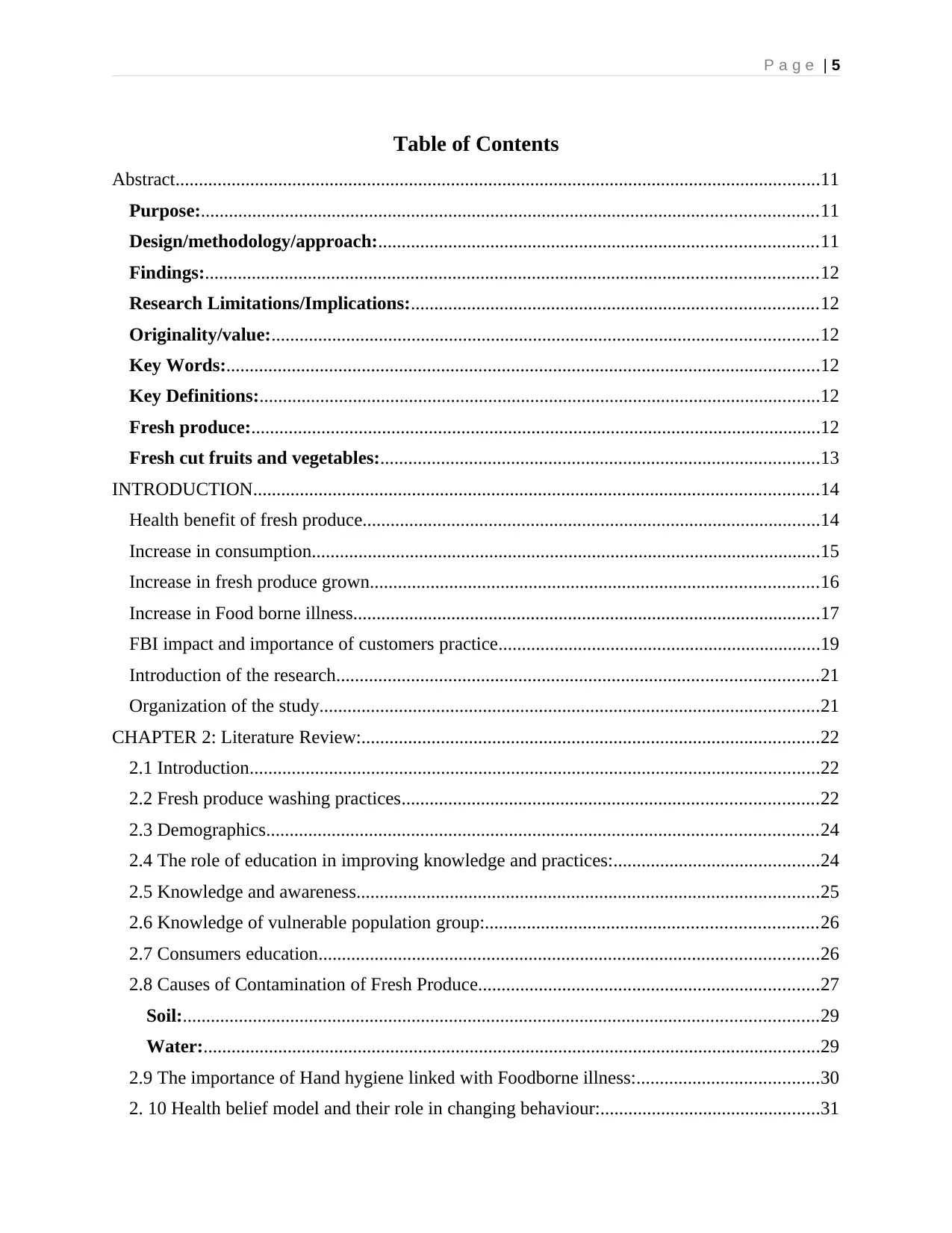
P a g e | 5
Table of Contents
Abstract..........................................................................................................................................11
Purpose:....................................................................................................................................11
Design/methodology/approach:..............................................................................................11
Findings:...................................................................................................................................12
Research Limitations/Implications:.......................................................................................12
Originality/value:.....................................................................................................................12
Key Words:...............................................................................................................................12
Key Definitions:........................................................................................................................12
Fresh produce:..........................................................................................................................12
Fresh cut fruits and vegetables:..............................................................................................13
INTRODUCTION.........................................................................................................................14
Health benefit of fresh produce..................................................................................................14
Increase in consumption.............................................................................................................15
Increase in fresh produce grown................................................................................................16
Increase in Food borne illness....................................................................................................17
FBI impact and importance of customers practice.....................................................................19
Introduction of the research.......................................................................................................21
Organization of the study...........................................................................................................21
CHAPTER 2: Literature Review:..................................................................................................22
2.1 Introduction..........................................................................................................................22
2.2 Fresh produce washing practices.........................................................................................22
2.3 Demographics......................................................................................................................24
2.4 The role of education in improving knowledge and practices:............................................24
2.5 Knowledge and awareness...................................................................................................25
2.6 Knowledge of vulnerable population group:.......................................................................26
2.7 Consumers education...........................................................................................................26
2.8 Causes of Contamination of Fresh Produce.........................................................................27
Soil:........................................................................................................................................29
Water:....................................................................................................................................29
2.9 The importance of Hand hygiene linked with Foodborne illness:.......................................30
2. 10 Health belief model and their role in changing behaviour:...............................................31
Table of Contents
Abstract..........................................................................................................................................11
Purpose:....................................................................................................................................11
Design/methodology/approach:..............................................................................................11
Findings:...................................................................................................................................12
Research Limitations/Implications:.......................................................................................12
Originality/value:.....................................................................................................................12
Key Words:...............................................................................................................................12
Key Definitions:........................................................................................................................12
Fresh produce:..........................................................................................................................12
Fresh cut fruits and vegetables:..............................................................................................13
INTRODUCTION.........................................................................................................................14
Health benefit of fresh produce..................................................................................................14
Increase in consumption.............................................................................................................15
Increase in fresh produce grown................................................................................................16
Increase in Food borne illness....................................................................................................17
FBI impact and importance of customers practice.....................................................................19
Introduction of the research.......................................................................................................21
Organization of the study...........................................................................................................21
CHAPTER 2: Literature Review:..................................................................................................22
2.1 Introduction..........................................................................................................................22
2.2 Fresh produce washing practices.........................................................................................22
2.3 Demographics......................................................................................................................24
2.4 The role of education in improving knowledge and practices:............................................24
2.5 Knowledge and awareness...................................................................................................25
2.6 Knowledge of vulnerable population group:.......................................................................26
2.7 Consumers education...........................................................................................................26
2.8 Causes of Contamination of Fresh Produce.........................................................................27
Soil:........................................................................................................................................29
Water:....................................................................................................................................29
2.9 The importance of Hand hygiene linked with Foodborne illness:.......................................30
2. 10 Health belief model and their role in changing behaviour:...............................................31
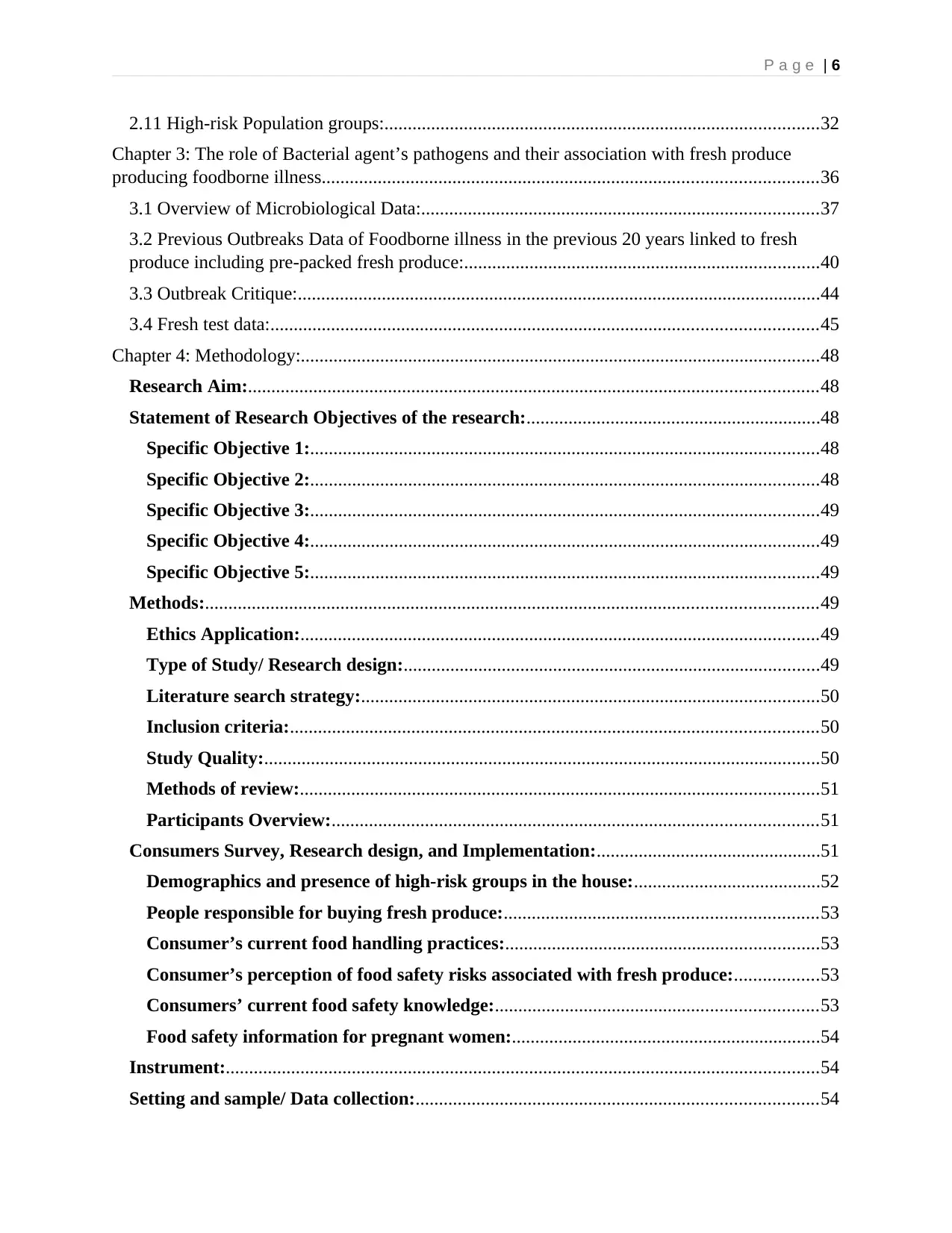
P a g e | 6
2.11 High-risk Population groups:.............................................................................................32
Chapter 3: The role of Bacterial agent’s pathogens and their association with fresh produce
producing foodborne illness..........................................................................................................36
3.1 Overview of Microbiological Data:.....................................................................................37
3.2 Previous Outbreaks Data of Foodborne illness in the previous 20 years linked to fresh
produce including pre-packed fresh produce:............................................................................40
3.3 Outbreak Critique:................................................................................................................44
3.4 Fresh test data:.....................................................................................................................45
Chapter 4: Methodology:...............................................................................................................48
Research Aim:..........................................................................................................................48
Statement of Research Objectives of the research:...............................................................48
Specific Objective 1:.............................................................................................................48
Specific Objective 2:.............................................................................................................48
Specific Objective 3:.............................................................................................................49
Specific Objective 4:.............................................................................................................49
Specific Objective 5:.............................................................................................................49
Methods:...................................................................................................................................49
Ethics Application:...............................................................................................................49
Type of Study/ Research design:.........................................................................................49
Literature search strategy:..................................................................................................50
Inclusion criteria:.................................................................................................................50
Study Quality:.......................................................................................................................50
Methods of review:...............................................................................................................51
Participants Overview:........................................................................................................51
Consumers Survey, Research design, and Implementation:................................................51
Demographics and presence of high-risk groups in the house:........................................52
People responsible for buying fresh produce:...................................................................53
Consumer’s current food handling practices:...................................................................53
Consumer’s perception of food safety risks associated with fresh produce:..................53
Consumers’ current food safety knowledge:.....................................................................53
Food safety information for pregnant women:..................................................................54
Instrument:...............................................................................................................................54
Setting and sample/ Data collection:......................................................................................54
2.11 High-risk Population groups:.............................................................................................32
Chapter 3: The role of Bacterial agent’s pathogens and their association with fresh produce
producing foodborne illness..........................................................................................................36
3.1 Overview of Microbiological Data:.....................................................................................37
3.2 Previous Outbreaks Data of Foodborne illness in the previous 20 years linked to fresh
produce including pre-packed fresh produce:............................................................................40
3.3 Outbreak Critique:................................................................................................................44
3.4 Fresh test data:.....................................................................................................................45
Chapter 4: Methodology:...............................................................................................................48
Research Aim:..........................................................................................................................48
Statement of Research Objectives of the research:...............................................................48
Specific Objective 1:.............................................................................................................48
Specific Objective 2:.............................................................................................................48
Specific Objective 3:.............................................................................................................49
Specific Objective 4:.............................................................................................................49
Specific Objective 5:.............................................................................................................49
Methods:...................................................................................................................................49
Ethics Application:...............................................................................................................49
Type of Study/ Research design:.........................................................................................49
Literature search strategy:..................................................................................................50
Inclusion criteria:.................................................................................................................50
Study Quality:.......................................................................................................................50
Methods of review:...............................................................................................................51
Participants Overview:........................................................................................................51
Consumers Survey, Research design, and Implementation:................................................51
Demographics and presence of high-risk groups in the house:........................................52
People responsible for buying fresh produce:...................................................................53
Consumer’s current food handling practices:...................................................................53
Consumer’s perception of food safety risks associated with fresh produce:..................53
Consumers’ current food safety knowledge:.....................................................................53
Food safety information for pregnant women:..................................................................54
Instrument:...............................................................................................................................54
Setting and sample/ Data collection:......................................................................................54
⊘ This is a preview!⊘
Do you want full access?
Subscribe today to unlock all pages.

Trusted by 1+ million students worldwide
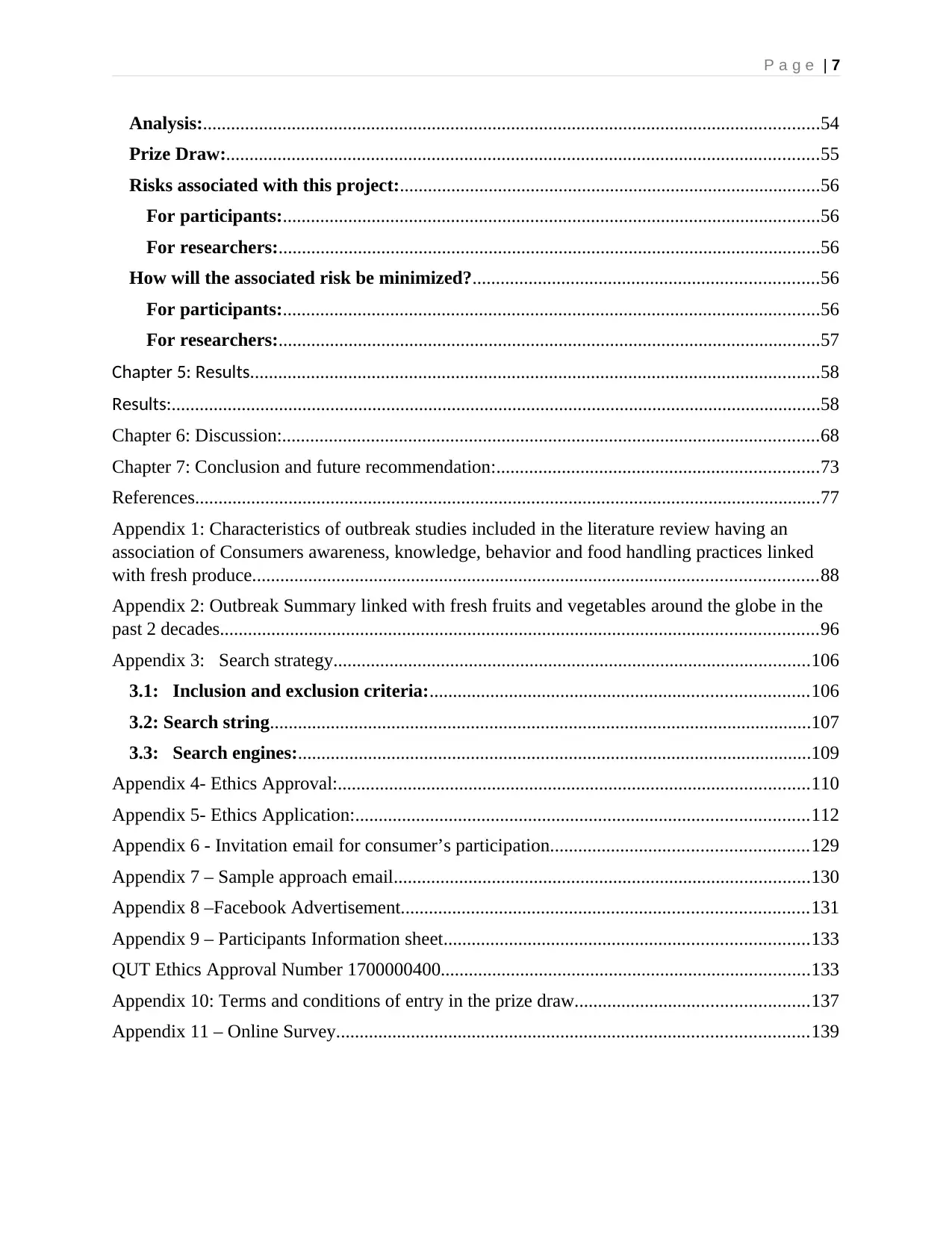
P a g e | 7
Analysis:....................................................................................................................................54
Prize Draw:...............................................................................................................................55
Risks associated with this project:..........................................................................................56
For participants:...................................................................................................................56
For researchers:....................................................................................................................56
How will the associated risk be minimized?..........................................................................56
For participants:...................................................................................................................56
For researchers:....................................................................................................................57
Chapter 5: Results..........................................................................................................................58
Results:...........................................................................................................................................58
Chapter 6: Discussion:...................................................................................................................68
Chapter 7: Conclusion and future recommendation:.....................................................................73
References......................................................................................................................................77
Appendix 1: Characteristics of outbreak studies included in the literature review having an
association of Consumers awareness, knowledge, behavior and food handling practices linked
with fresh produce.........................................................................................................................88
Appendix 2: Outbreak Summary linked with fresh fruits and vegetables around the globe in the
past 2 decades................................................................................................................................96
Appendix 3: Search strategy......................................................................................................106
3.1: Inclusion and exclusion criteria:.................................................................................106
3.2: Search string....................................................................................................................107
3.3: Search engines:..............................................................................................................109
Appendix 4- Ethics Approval:.....................................................................................................110
Appendix 5- Ethics Application:.................................................................................................112
Appendix 6 - Invitation email for consumer’s participation.......................................................129
Appendix 7 – Sample approach email.........................................................................................130
Appendix 8 –Facebook Advertisement.......................................................................................131
Appendix 9 – Participants Information sheet..............................................................................133
QUT Ethics Approval Number 1700000400...............................................................................133
Appendix 10: Terms and conditions of entry in the prize draw..................................................137
Appendix 11 – Online Survey.....................................................................................................139
Analysis:....................................................................................................................................54
Prize Draw:...............................................................................................................................55
Risks associated with this project:..........................................................................................56
For participants:...................................................................................................................56
For researchers:....................................................................................................................56
How will the associated risk be minimized?..........................................................................56
For participants:...................................................................................................................56
For researchers:....................................................................................................................57
Chapter 5: Results..........................................................................................................................58
Results:...........................................................................................................................................58
Chapter 6: Discussion:...................................................................................................................68
Chapter 7: Conclusion and future recommendation:.....................................................................73
References......................................................................................................................................77
Appendix 1: Characteristics of outbreak studies included in the literature review having an
association of Consumers awareness, knowledge, behavior and food handling practices linked
with fresh produce.........................................................................................................................88
Appendix 2: Outbreak Summary linked with fresh fruits and vegetables around the globe in the
past 2 decades................................................................................................................................96
Appendix 3: Search strategy......................................................................................................106
3.1: Inclusion and exclusion criteria:.................................................................................106
3.2: Search string....................................................................................................................107
3.3: Search engines:..............................................................................................................109
Appendix 4- Ethics Approval:.....................................................................................................110
Appendix 5- Ethics Application:.................................................................................................112
Appendix 6 - Invitation email for consumer’s participation.......................................................129
Appendix 7 – Sample approach email.........................................................................................130
Appendix 8 –Facebook Advertisement.......................................................................................131
Appendix 9 – Participants Information sheet..............................................................................133
QUT Ethics Approval Number 1700000400...............................................................................133
Appendix 10: Terms and conditions of entry in the prize draw..................................................137
Appendix 11 – Online Survey.....................................................................................................139
Paraphrase This Document
Need a fresh take? Get an instant paraphrase of this document with our AI Paraphraser
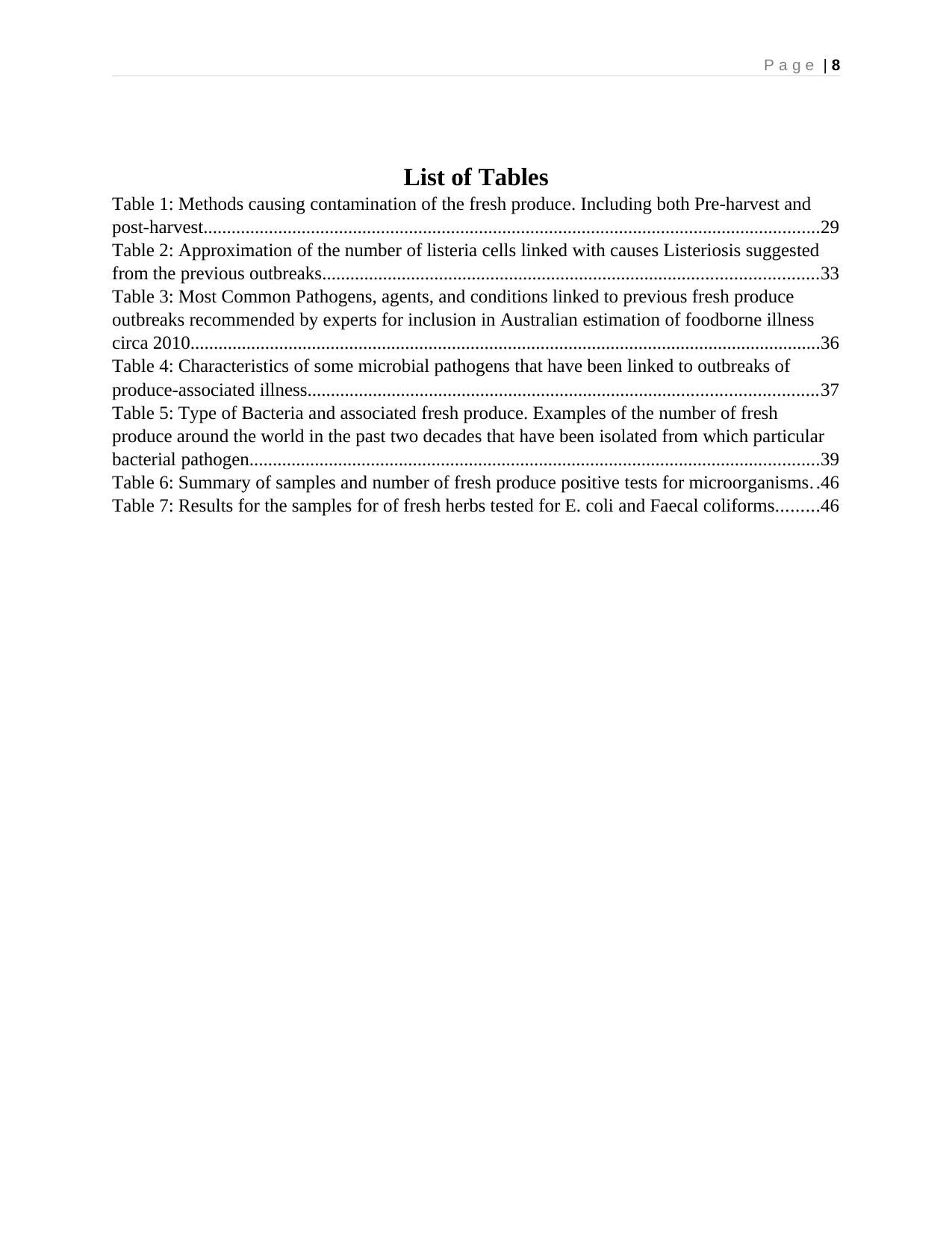
P a g e | 8
List of Tables
Table 1: Methods causing contamination of the fresh produce. Including both Pre-harvest and
post-harvest....................................................................................................................................29
Table 2: Approximation of the number of listeria cells linked with causes Listeriosis suggested
from the previous outbreaks..........................................................................................................33
Table 3: Most Common Pathogens, agents, and conditions linked to previous fresh produce
outbreaks recommended by experts for inclusion in Australian estimation of foodborne illness
circa 2010.......................................................................................................................................36
Table 4: Characteristics of some microbial pathogens that have been linked to outbreaks of
produce-associated illness.............................................................................................................37
Table 5: Type of Bacteria and associated fresh produce. Examples of the number of fresh
produce around the world in the past two decades that have been isolated from which particular
bacterial pathogen..........................................................................................................................39
Table 6: Summary of samples and number of fresh produce positive tests for microorganisms. .46
Table 7: Results for the samples for of fresh herbs tested for E. coli and Faecal coliforms.........46
List of Tables
Table 1: Methods causing contamination of the fresh produce. Including both Pre-harvest and
post-harvest....................................................................................................................................29
Table 2: Approximation of the number of listeria cells linked with causes Listeriosis suggested
from the previous outbreaks..........................................................................................................33
Table 3: Most Common Pathogens, agents, and conditions linked to previous fresh produce
outbreaks recommended by experts for inclusion in Australian estimation of foodborne illness
circa 2010.......................................................................................................................................36
Table 4: Characteristics of some microbial pathogens that have been linked to outbreaks of
produce-associated illness.............................................................................................................37
Table 5: Type of Bacteria and associated fresh produce. Examples of the number of fresh
produce around the world in the past two decades that have been isolated from which particular
bacterial pathogen..........................................................................................................................39
Table 6: Summary of samples and number of fresh produce positive tests for microorganisms. .46
Table 7: Results for the samples for of fresh herbs tested for E. coli and Faecal coliforms.........46

P a g e | 9
List of Figures
Figure 1: Conceptual framework of causes of foodborne illness in consumers linked to fresh
produce..........................................................................................................................................19
Figure 2: Sources and roots of contamination of fresh produce....................................................28
Figure 3: Diagrammatic representation of causes of contamination of fresh produce. Taken from
“A quantitative microbial risk assessment of water in the fresh produce chain”..........................30
Figure 4: An interactive model of Theory of Planned Behaviour.................................................32
List of Figures
Figure 1: Conceptual framework of causes of foodborne illness in consumers linked to fresh
produce..........................................................................................................................................19
Figure 2: Sources and roots of contamination of fresh produce....................................................28
Figure 3: Diagrammatic representation of causes of contamination of fresh produce. Taken from
“A quantitative microbial risk assessment of water in the fresh produce chain”..........................30
Figure 4: An interactive model of Theory of Planned Behaviour.................................................32
⊘ This is a preview!⊘
Do you want full access?
Subscribe today to unlock all pages.

Trusted by 1+ million students worldwide

P a g e | 10
Paraphrase This Document
Need a fresh take? Get an instant paraphrase of this document with our AI Paraphraser
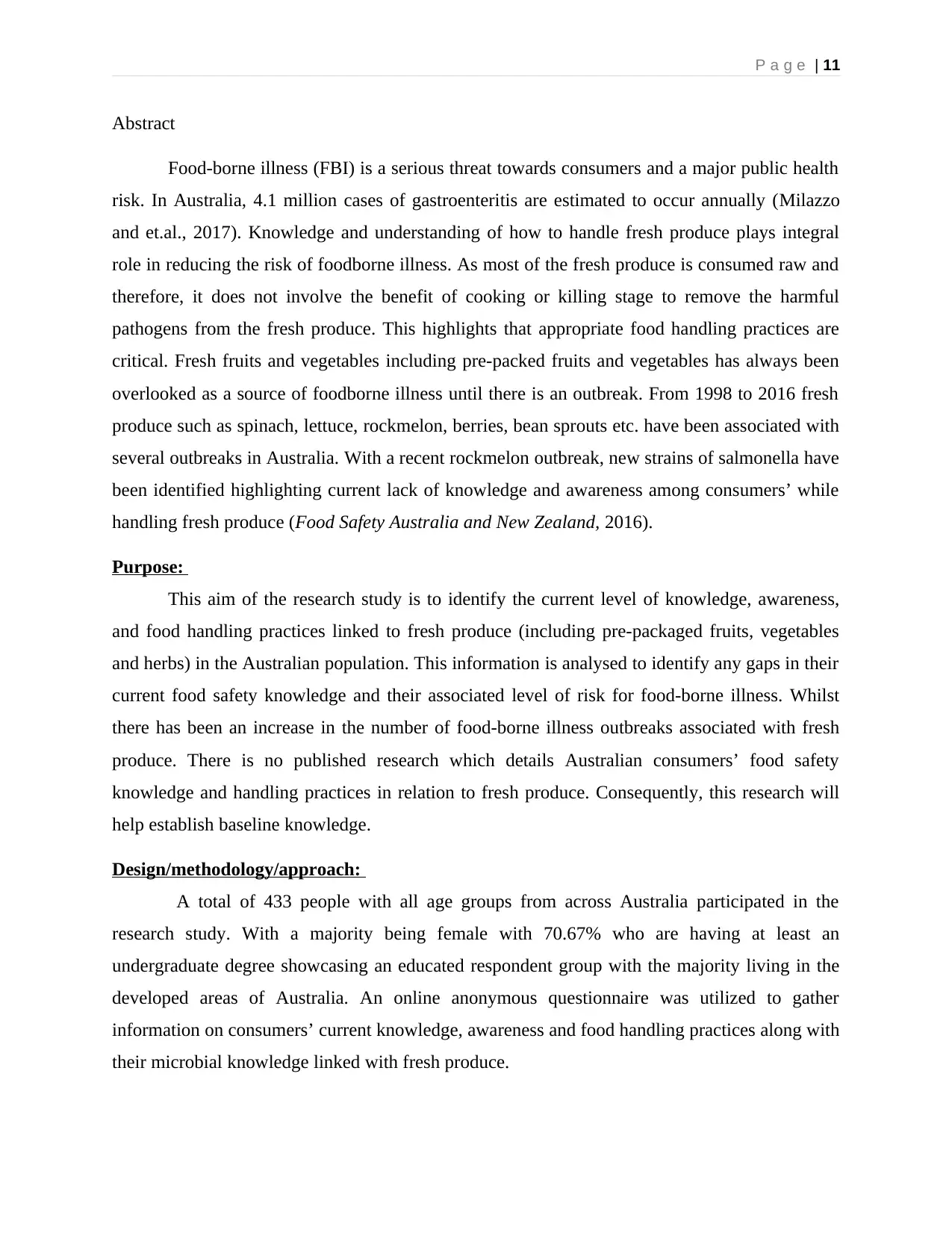
P a g e | 11
Abstract
Food-borne illness (FBI) is a serious threat towards consumers and a major public health
risk. In Australia, 4.1 million cases of gastroenteritis are estimated to occur annually (Milazzo
and et.al., 2017). Knowledge and understanding of how to handle fresh produce plays integral
role in reducing the risk of foodborne illness. As most of the fresh produce is consumed raw and
therefore, it does not involve the benefit of cooking or killing stage to remove the harmful
pathogens from the fresh produce. This highlights that appropriate food handling practices are
critical. Fresh fruits and vegetables including pre-packed fruits and vegetables has always been
overlooked as a source of foodborne illness until there is an outbreak. From 1998 to 2016 fresh
produce such as spinach, lettuce, rockmelon, berries, bean sprouts etc. have been associated with
several outbreaks in Australia. With a recent rockmelon outbreak, new strains of salmonella have
been identified highlighting current lack of knowledge and awareness among consumers’ while
handling fresh produce (Food Safety Australia and New Zealand, 2016).
Purpose:
This aim of the research study is to identify the current level of knowledge, awareness,
and food handling practices linked to fresh produce (including pre-packaged fruits, vegetables
and herbs) in the Australian population. This information is analysed to identify any gaps in their
current food safety knowledge and their associated level of risk for food-borne illness. Whilst
there has been an increase in the number of food-borne illness outbreaks associated with fresh
produce. There is no published research which details Australian consumers’ food safety
knowledge and handling practices in relation to fresh produce. Consequently, this research will
help establish baseline knowledge.
Design/methodology/approach:
A total of 433 people with all age groups from across Australia participated in the
research study. With a majority being female with 70.67% who are having at least an
undergraduate degree showcasing an educated respondent group with the majority living in the
developed areas of Australia. An online anonymous questionnaire was utilized to gather
information on consumers’ current knowledge, awareness and food handling practices along with
their microbial knowledge linked with fresh produce.
Abstract
Food-borne illness (FBI) is a serious threat towards consumers and a major public health
risk. In Australia, 4.1 million cases of gastroenteritis are estimated to occur annually (Milazzo
and et.al., 2017). Knowledge and understanding of how to handle fresh produce plays integral
role in reducing the risk of foodborne illness. As most of the fresh produce is consumed raw and
therefore, it does not involve the benefit of cooking or killing stage to remove the harmful
pathogens from the fresh produce. This highlights that appropriate food handling practices are
critical. Fresh fruits and vegetables including pre-packed fruits and vegetables has always been
overlooked as a source of foodborne illness until there is an outbreak. From 1998 to 2016 fresh
produce such as spinach, lettuce, rockmelon, berries, bean sprouts etc. have been associated with
several outbreaks in Australia. With a recent rockmelon outbreak, new strains of salmonella have
been identified highlighting current lack of knowledge and awareness among consumers’ while
handling fresh produce (Food Safety Australia and New Zealand, 2016).
Purpose:
This aim of the research study is to identify the current level of knowledge, awareness,
and food handling practices linked to fresh produce (including pre-packaged fruits, vegetables
and herbs) in the Australian population. This information is analysed to identify any gaps in their
current food safety knowledge and their associated level of risk for food-borne illness. Whilst
there has been an increase in the number of food-borne illness outbreaks associated with fresh
produce. There is no published research which details Australian consumers’ food safety
knowledge and handling practices in relation to fresh produce. Consequently, this research will
help establish baseline knowledge.
Design/methodology/approach:
A total of 433 people with all age groups from across Australia participated in the
research study. With a majority being female with 70.67% who are having at least an
undergraduate degree showcasing an educated respondent group with the majority living in the
developed areas of Australia. An online anonymous questionnaire was utilized to gather
information on consumers’ current knowledge, awareness and food handling practices along with
their microbial knowledge linked with fresh produce.
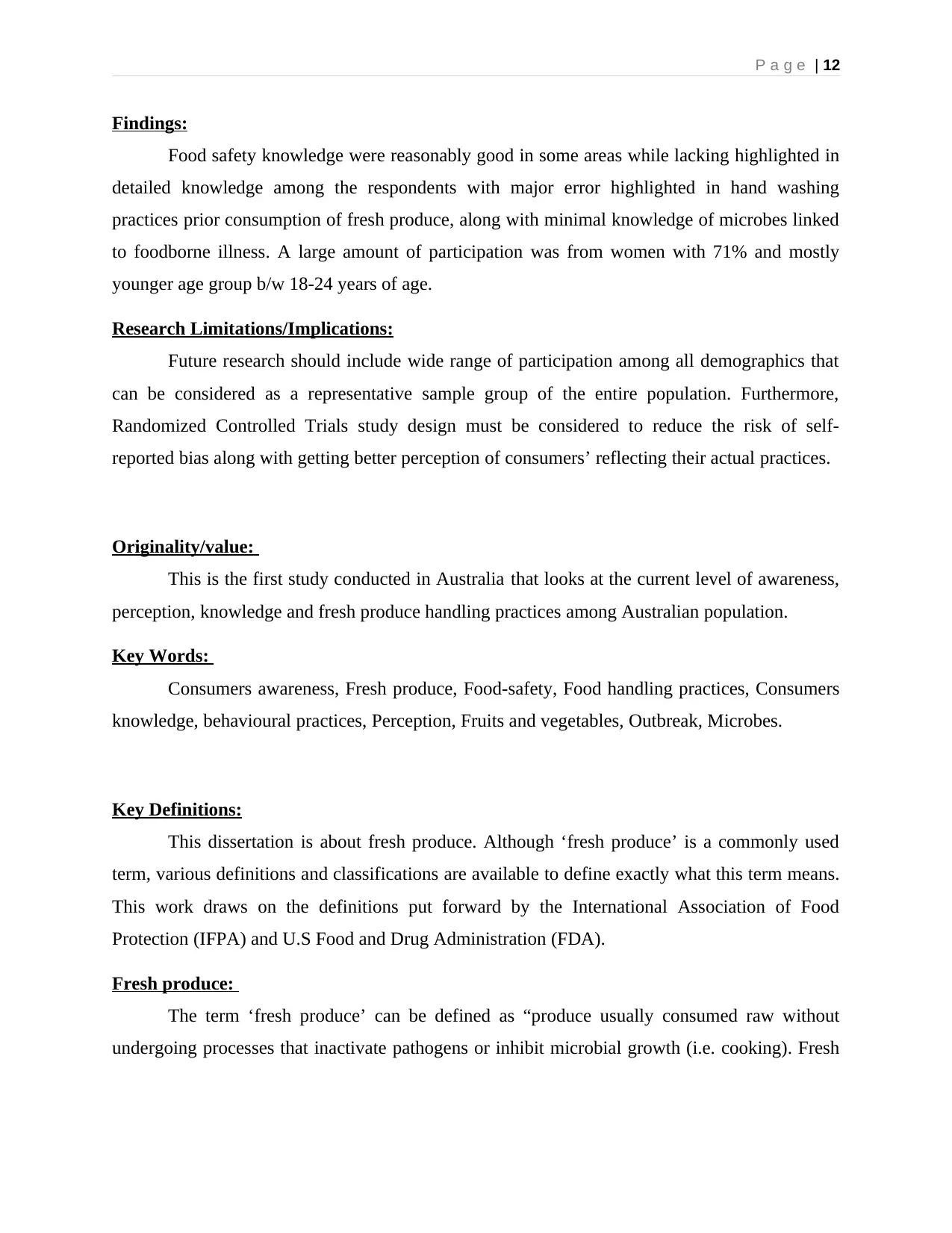
P a g e | 12
Findings:
Food safety knowledge were reasonably good in some areas while lacking highlighted in
detailed knowledge among the respondents with major error highlighted in hand washing
practices prior consumption of fresh produce, along with minimal knowledge of microbes linked
to foodborne illness. A large amount of participation was from women with 71% and mostly
younger age group b/w 18-24 years of age.
Research Limitations/Implications:
Future research should include wide range of participation among all demographics that
can be considered as a representative sample group of the entire population. Furthermore,
Randomized Controlled Trials study design must be considered to reduce the risk of self-
reported bias along with getting better perception of consumers’ reflecting their actual practices.
Originality/value:
This is the first study conducted in Australia that looks at the current level of awareness,
perception, knowledge and fresh produce handling practices among Australian population.
Key Words:
Consumers awareness, Fresh produce, Food-safety, Food handling practices, Consumers
knowledge, behavioural practices, Perception, Fruits and vegetables, Outbreak, Microbes.
Key Definitions:
This dissertation is about fresh produce. Although ‘fresh produce’ is a commonly used
term, various definitions and classifications are available to define exactly what this term means.
This work draws on the definitions put forward by the International Association of Food
Protection (IFPA) and U.S Food and Drug Administration (FDA).
Fresh produce:
The term ‘fresh produce’ can be defined as “produce usually consumed raw without
undergoing processes that inactivate pathogens or inhibit microbial growth (i.e. cooking). Fresh
Findings:
Food safety knowledge were reasonably good in some areas while lacking highlighted in
detailed knowledge among the respondents with major error highlighted in hand washing
practices prior consumption of fresh produce, along with minimal knowledge of microbes linked
to foodborne illness. A large amount of participation was from women with 71% and mostly
younger age group b/w 18-24 years of age.
Research Limitations/Implications:
Future research should include wide range of participation among all demographics that
can be considered as a representative sample group of the entire population. Furthermore,
Randomized Controlled Trials study design must be considered to reduce the risk of self-
reported bias along with getting better perception of consumers’ reflecting their actual practices.
Originality/value:
This is the first study conducted in Australia that looks at the current level of awareness,
perception, knowledge and fresh produce handling practices among Australian population.
Key Words:
Consumers awareness, Fresh produce, Food-safety, Food handling practices, Consumers
knowledge, behavioural practices, Perception, Fruits and vegetables, Outbreak, Microbes.
Key Definitions:
This dissertation is about fresh produce. Although ‘fresh produce’ is a commonly used
term, various definitions and classifications are available to define exactly what this term means.
This work draws on the definitions put forward by the International Association of Food
Protection (IFPA) and U.S Food and Drug Administration (FDA).
Fresh produce:
The term ‘fresh produce’ can be defined as “produce usually consumed raw without
undergoing processes that inactivate pathogens or inhibit microbial growth (i.e. cooking). Fresh
⊘ This is a preview!⊘
Do you want full access?
Subscribe today to unlock all pages.

Trusted by 1+ million students worldwide
1 out of 153
Your All-in-One AI-Powered Toolkit for Academic Success.
+13062052269
info@desklib.com
Available 24*7 on WhatsApp / Email
![[object Object]](/_next/static/media/star-bottom.7253800d.svg)
Unlock your academic potential
Copyright © 2020–2025 A2Z Services. All Rights Reserved. Developed and managed by ZUCOL.
